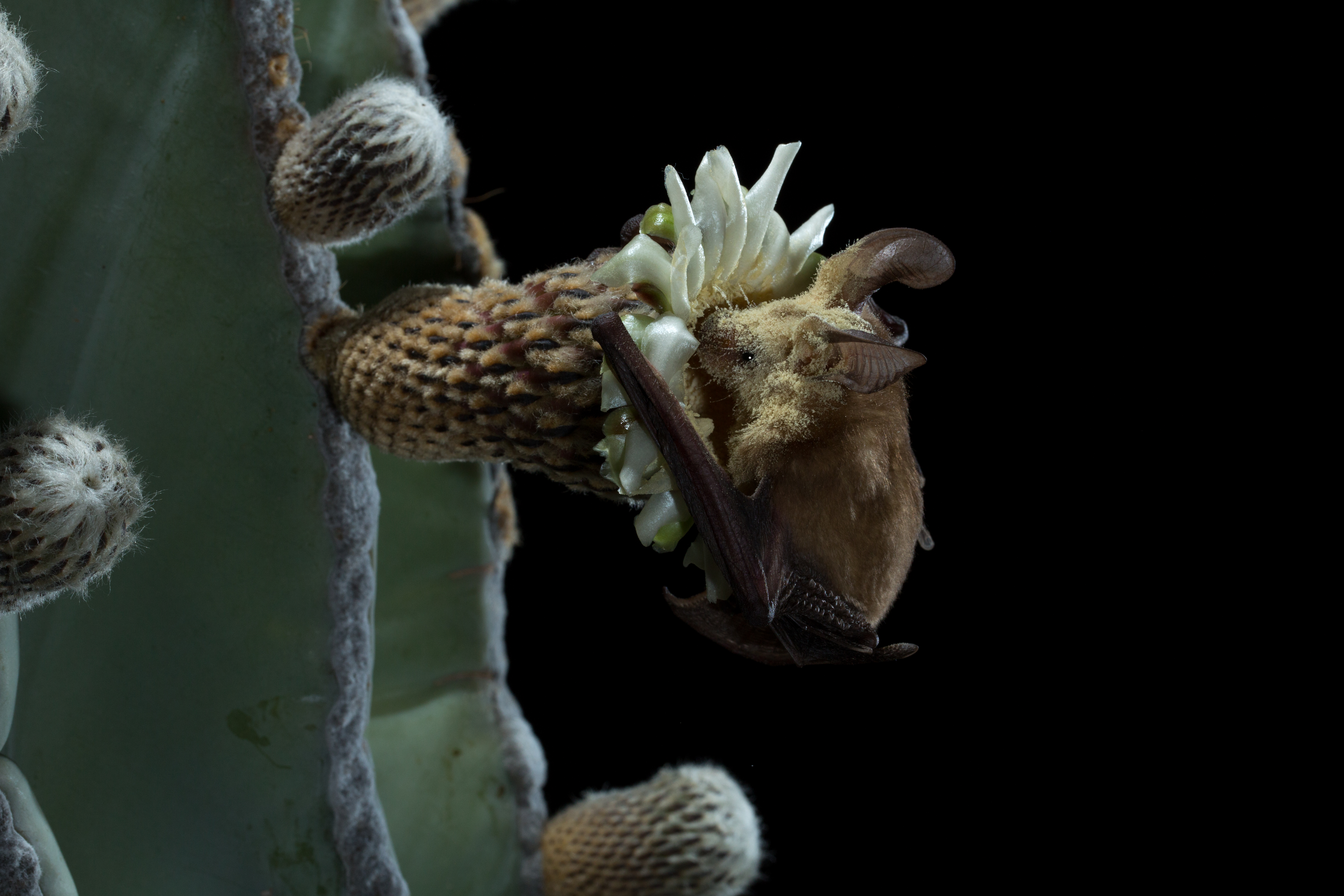
by Bryan Jáuregui | Blog, Plants, Wildlife
by Bryan Batson Jáuregui, Todos Santos Eco Adventures
This article first appeared in Janice Kinne’s Journal del Pacifico.
The cardón cactus, endemic to Baja California, is one of the most massive and ubiquitous cacti on the planet. Huge groves of multi-limbed old timers that witnessed the arrival of the first Europeans over five centuries ago can still be seen the length of the peninsula, and single young upstarts that haven’t even sent up their first arm yet crowd the desert landscape. What accounts for such rampant success? In a word, bats. Now of course there are many factors that help the cardón survive – isolation, summer rains, water retaining skeletons – but none of this would matter if it wasn’t for the bat, because the cardón is a cactus that deigns to open its flowers for pollination only as the sun is setting, a time when the kings of the PM pollination scene are emerging from their caves ravenous for their first meal of the night. That’s right, bats.
But not just any bat. Researchers have known for years about the role of the lesser long-nosed bat (Leptonycteris yerbabuenae) in cardon pollination. In fact, when a young graduate student named Winifred Frick arrived in Baja in 2004 to work on her dissertation in bat ecology, the lesser long-nosed bat was considered the only cardón pollinator game in town. Says Frick, “The lesser long-nosed bat is highly specialized for nectar-feeding. It can hover at an open cardón flower and use its
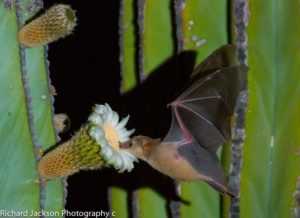
Lesser long-nosed bat. Photo by Rick Jackson.
long tongue to extract nectar, transferring pollen from one flower to the next in the process.” Clean, precise, targeted. Evolution at its most elegant. “So I was really surprised to see this other desert bat, the pallid bat (Antrozous pallidus), regularly visiting cardón flowers. The pallid bat has a short face, long ears and loves to eat scorpions off the ground. At first I thought maybe it was visiting the bat-adapted flowers of the cardon to opportunistically glean insects attracted to the flowers. But as we observed it over 2005-2007, we realized that the pallid bat was actually indulging in cardón flower nectar. Apparently it likes a little something sweet to wash down savory scorpion meals. However, unlike the lesser long-nosed bat, the pallid bat doesn’t hover but dives onto the whole flower, caking its whole body in pollen.” A cardón pollinator usurper?
Frick, now Dr. Frick of the Department of Ecology and Evolutionary Biology at the University of California, Santa Cruz, was doing her dissertation on “the relationship between the size and isolation of (Baja) islands and bat species richness in a near-shore archipelago …” so didn’t follow up on her pallid bat observations at the time. But she didn’t forget the pollen-laden pallids, and a few years later teamed up with some of her UC Santa Cruz colleagues to study bats and cardón pollination in more depth, resulting in game-changing research that was published in American Naturalist in 2012 (Frick is the lead author of the study conducted with her colleagues Ryan Price, Paul Heady and Kathleen Kay). For the study, which was funded in part by the National Geographic Society and UC MEXUS, Frick and her team monitored cardón flowers at several sites in southern Baja. When they saw a bat visit a flower they would identify which of the two cardón-nectar-loving rivals it was, then retrieve the stigma of the flower to determine how many grains of pollen the bat had deposited. They also recorded the total number of flower visits by each of the two species at each study site. Turns out, pollination’s not just for the long-nosed crowd.
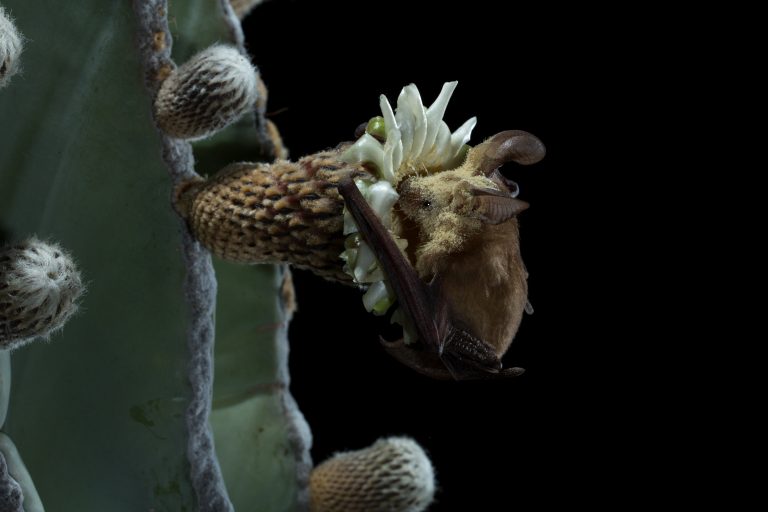
Pallid Bat on Cardon Flower. Photo by Merlin Tuttle. http://merlintuttle.org
“The results blew us away. The lesser long-nosed bat has an ancient cardón-pollinating lineage that has been co-evolving with the cardón flower for a very long time. We were therefore very surprised to see that the newby, the pallid bat, is a far more effective pollinator, delivering about 8 times as much pollen per visit. We observed several factors that account for this. One is that the pallid bat rests its body on the flower and plunges its whole head into the flower to get at the nectar. It therefore gets far more pollen on its body than the hovering lesser long-nosed bat, who is using its tongue only to access nectar. So this new pollinator is actually better than the more specialized pollinator because it is not well-adapted to nectar feeding. (The pallid is the only nectar feeder from an insect-feeding family, Vespertilionidae). Its stats are also helped by the fact that the lesser long-nosed bat uses pollen as a source of protein, so therefore regularly eats the pollen off its fur, reducing the amount available for pollination. Finally, the lesser long-nosed bat is migratory while the pallid bat is a year-round Baja resident, a fact that makes the pallid bat especially important to the cardón.”
The cardón. Amazing record of longevity and survival. How has it done that? It has been scientifically shown that plants respond to stimuli such as sound and touch. Some wounded plants produce a chemical that acts as an alarm signal, prompting nearby plants to produce chemicals that help them defend themselves against insects – or attract insect predators. Venus fly traps just eat the interlopers. So is it possible that the cardón has sensed that it’s a hair risky to continue entrusting its future solely to an endangered, migratory, picky eater like the lesser long-nosed bat? Has it therefore made its flower scent / nectar taste so enticing that even – or perhaps especially – a scorpion-loving, insect-grubbing, and – until recently – flower-snubbing permanent Baja resident like the pallid bat would literally plunge in head first to its rescue? Says Frick’s co-author Kathleen Kay, “What is actually happening in terms of how species are mutually interacting can be more complicated than what meets the eye.” Wily cardón. Lucky bats.
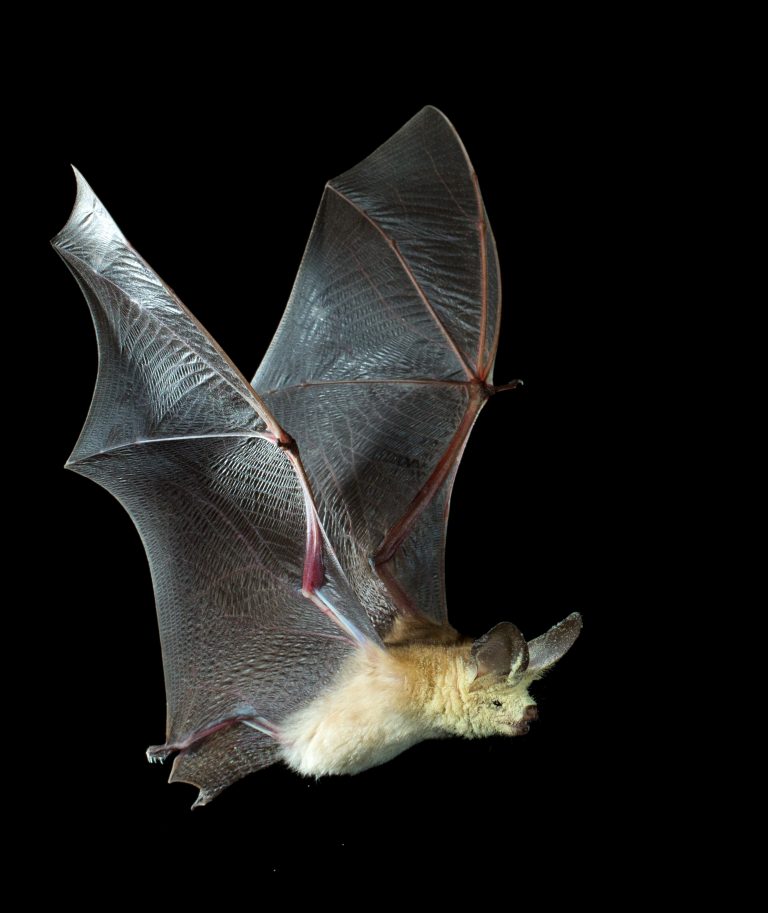
Pallid bat photo by Merlin Tuttle. http://merlintuttle.org
Photographer Merlin Tuttle
Merlin Tuttle decided to devote the remainder of his career to bat conservation in 1982 “as an act of desperation. It was obvious that without major improvement in public attitudes, the situation for bats would continue to worsen.” Battered by centuries of harmful myths and misinformation, bats were despised and casually slaughtered around the world. Merlin has made education – correcting those myths and teaching the economic and ecosystem benefits of bats – a major part of his work. Distressed that most bat photographs showed roughly handled bats snarling in self-defense,Merlin taught himself photography. He became a world-class wildlife photographer whose images have appeared in books and magazines around the world and played a crucial part in his education efforts. To view his amazing photographs and contribute to his bat conservation efforts, please visit http://merlintuttle.org/.
© Copyright Sergio and Bryan Jauregui, Casa Payaso S de RL de CV, 2015
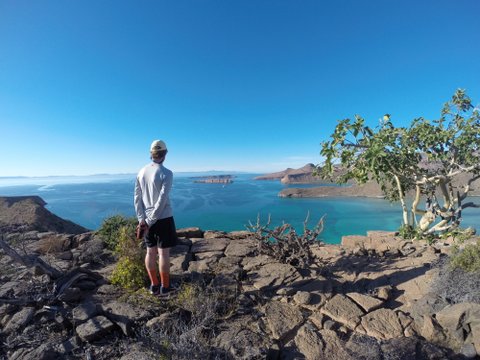
by Bryan Jáuregui | Adventure, Blog, Culture, Wildlife
by Bryan Jáuregui, Todos Santos Eco Adventures
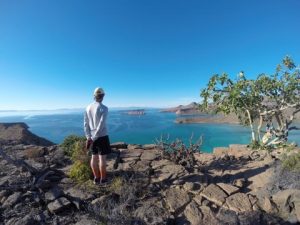
Espiritu Santo photo by Carlos Gajon
If famed aviator Charles Lindbergh had not fallen in love with the daughter of the US Ambassador to Mexico, the story of Isla Espiritu Santo might be just another sad tale of extraordinary natural beauty undone. But the courtship of his future wife in Mexico instilled in Lindbergh a lasting affection for the country. So when in 1973 his friend and fellow conservationist George Lindsey invited him on a scientific exploration of the Sea of Cortez, Lindbergh jumped at the chance. The two men and their scientific team wended their way through numerous islands between Bahia de Los Angeles and La Paz, ultimately arriving at Espiritu Santo. Lindbergh was enthralled. The islands made such an enormous impression on him that during a trip to Mexico City a few months later, Lindbergh requested a meeting with the president of Mexico to discuss protecting what he now considered one of the most beautiful areas on the planet, the Sea of Cortez. Four years later the Mexican government issued a decree establishing 898 islands of the Sea of Cortez a Flora and Fauna Protection Area (Zona de Reserva Natural y Refugio de Aves Migratorias y de la Fauna Silvestre). George Lindsey, then the Director of the San Diego Natural History Museum, strongly believes that Lindbergh’s intervention helped to create the governmental awareness needed to get the decree enacted. It was a good beginning.
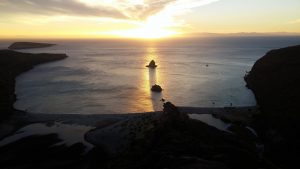
Espiritu Santo photo by Cabo Rockwell
Around the same time as Lindbergh’s transformational trip to Baja, a former Grand Canyon river guide named Tim Means was setting up the first major ecotourism company in La Paz, Baja Expeditions. Means’ business thrived as word of Baja’s remarkable flora and fauna spread, and demand grew for access to the natural wonders that the area’s remote location had kept pristine long after the west coast of the US had been heavily developed. But conservation-minded eco adventurers were not the only ones attracted to the area, and by the 1990s the pressure on Isla Espiritu Santo was intense: a real estate developer wanted to create a resort casino on the island. From the outside it seemed absurd that a casino had even the remotest possibility of being approved in a natural protected area, but Mexico’s traditionally lax approach to conservation enforcement afforded the developer optimism.
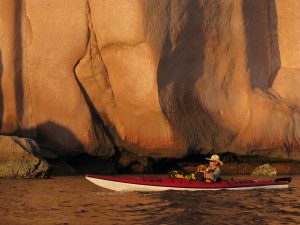
Espiritu Santo photo by Craig Ligibel
While most of the islands in the Sea of Cortez were federal lands, a few were privately owned, and Espiritu Santo was owned by an ejido. Ejidos, created as part of Mexico’s land reform movement after the Revolution of 1910, are rural collectives of people who own property communally. Traditionally ejidos were not allowed to sell their property, but the constitutional obstructions to ejido land sales were removed in 1992, and the ejido owners of Espiritu Santo lost little time in taking advantage of this new freedom. By 1997 they had sub-divided 90 hectares around Bonanza Beach into 36 lots and were selling them off. Cabins were actually constructed on some of the lots, but in a move that would have made Lindbergh proud, a federal judge deemed them illegal under the 1978 decree and they were torn down. But the real estate developer who owned some of the properties was pushing hard on his casino proposal. Tim Means was prepared to push back.
Means started his onslaught by personally buying two properties smack in the middle of the developer’s proposed casino area. This immediately diminished the attractiveness of the project for the developer, and inclined him towards negotiation. Means then enlisted the aid of leading Mexican businessmen in the area, who retained and paid for the law firm that was ultimately able to arrange the buy out the developer and all but one of the remaining properties for sale on Bonanza Beach. This all took a great deal of time and maneuvering, but Means and his team persevered. All the properties they bought were donated to the federal government.
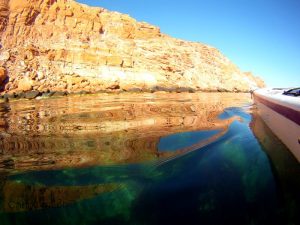
Espiritu Santo photo by Carlos Gajon
When the immediate threat of the casino was neutralized, Means and a coalition of conservationists were able to put together a deal to purchase the rest of the island, which they bought from the ejido for US$3.3 million. Their subsequent donation of Espiritu Santo to the nation is commemorated by a famous sculpture of a dove on the malecon in La Paz.
The purchase structure that resulted in Espiritu Santo’s conservation in perpetuity demonstrates the power of collaboration among a diverse group of constituents when fighting to preserve wilderness areas: about one third of the money came from Mexican funders, another third from American funders via the Nature Conservancy, and the rest through an anonymous gift to the World Wildlife Fund. The David and Lucille Packard Foundation then donated US$1.5 million towards the future management of Espiritu Santo. This type of international cooperation set the stage for future and ongoing battles against mega-developments elsewhere in Baja California Sur. As a direct result of Means’ successful activism, Espiritu Santo and 244 other islands in the Sea of Cortez were subsequently named a World Heritage Site in 2005.
But none of this would have happened without the will of the Mexican people. As a result of colonial rule, the Mexican citizenry traditionally felt they had no voice in government, so agitation for change was not a big feature of public life. But in the 1970s this started to change, most notably in the environmental arena, and Mexicans began to create organizations committed to protecting the country’s immense natural resources. This process lead to the creation of the Secretaria de Desarollo Urbano y Ecologia (Secretary of Urban Development and Ecology) in 1983, and in 1987 the general law of ecology and natural resources. One of the early successes of all this effort was the 1988 declaration of the Monarch Butterfly Biosphere Reserve in the states of Mexico and Michoacan.
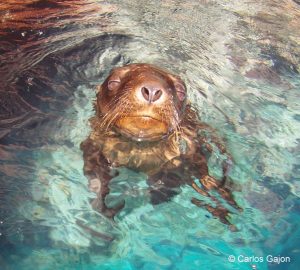
Worthy of Protection. Photo by Carlos Gajon.
The people of Mexico in general, and of Baja California Sur in particular, are now intently focused on protecting their natural heritage. In Baja California Sur residents have banded together in recent years to defeat mega-developments in Balandra Bay, El Mogote and Cabo Pulmo, using the reach and resources of both local and international NGOs to aid their cause (See our blog post Conserving the Beauty of Baja). Public outrage and grassroots campaigning have stymied the efforts of companies seeking to operate open-pit gold mining companies in the Sierra de la Laguna Mountains. Like Lindbergh and his nonstop solo flight across the Atlantic, they are succeeding against considerable odds. Like Tim Means and his environmental coalitions, they are hunkered down and ready for the long haul. As the great conservationist Teddy Roosevelt once said, “Great thoughts speak only to the thoughtful mind, but great actions speak to all mankind.” The protection of Isla Espiritu Santo and the islands of the Sea of Cortez wrought by Tim Means and his coalition will speak to the world for generations to come.
Sources: Two excellent books and Tim Means provided the source material for this article. The books are Isla Espiritu Santo: Evolución, rescate y conservación by Exequiel Ezcurra, Harumi Fujita, Enrique Hambleton and Rodolfo Garrio; and Wildlands Philanthropy: The Great American Tradition with essays by Tom Butler and photographs by Antonio Vizcaino.
Todos Santos Eco Adventures operates a tent camp on Isla Espiritu Santo from which visitors can explore the wild natural beauty of the island and the Sea of Cortez.
Why do we care about Espiritu Santo and other areas of Mexico?
There are over 200 countries in the world today but only 12 of them can claim to be “mega-diverse”. A country is considered mega-diverse if it has between 60% and 70% of the total biodiversity of the planet, and Mexico is one of only 3 such countries with coastlines on both the Atlantic and Pacific (the United States and Colombia are the other two). Mexican government sources indicate that Mexico’s global ranks for biodiversity are as follows:
- Reptiles: #2
- Mammals: #3
- Amphibians: #5
- Vascular plants: #5
- Birds: #8
That’s something worth bragging about – and protecting!
This article was first published in Janice Kinne’s Journal del Pacifico
© Copyright Sergio and Bryan Jauregui, Casa Payaso S de RL de CV, 2015
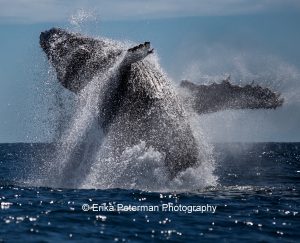
by Bryan Jáuregui | Adventure, Blog, Education, Wildlife
by Bryan Jáuregui, Todos Santos Eco Adventures
If science had all the answers, poets and dreamers would be out of a job. So when scientists tell us that they’re not really sure why humpback males sing – and it is only the males that sing – then it’s up to the rest of us to look at the evidence and help science along. And here’s what the evidence shows us. Like traditional mariachis, all-male college a capela groups, and the Rat Pack, humpback whales in Baja clearly understand that singing, particularly with the harmonious help of your mates, is the best way to get the girl. Now some scientists theorize that humpback males are singing only as a type of echolocation exercise of the type used by their dolphin cousins, a way to map out the world around them. This certainly
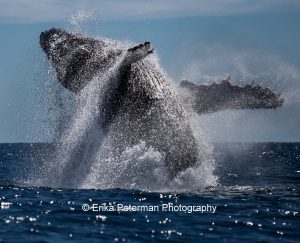
Humpback Happiness. Photo by Erika Peterman
may be true – because how else are they going to find the girls? But that really doesn’t explain why some humpback whale songs are several hours long and, according to the Journal of the Acoustical Society of America, grammatically complex and loaded with information. Like a ballad. Or why sexually immature young males join their virile older brothers in song. Like frat boys with their pledges beneath a sorority girl’s window. Or why all the males in one region will congregate in an arena and sing the same song. Like a boy-band in an outdoor stadium. Or why a male escorting a female and her calf will sing. Like a lullaby. These are all great mysteries that the poets are currently best equipped to ponder, but they don’t begin to touch on the greatest mystery of all – how does the female humpback decide which singer is worthy of her affections? Science presently has no answer, but maybe this is why Elvis always sang alone.
This article was originally published in Janice Kinne’s Journal del Pacifico
© Copyright Sergio and Bryan Jáuregui, Casa Payaso S de RL de CV, 2014
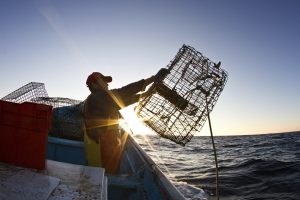
by Bryan Jáuregui | Blog, Culture, Education, Food, Wildlife
By Bryan Jáuregui, Todos Santo Eco Adventures
This article first appeared in Janice Kinne’s Journal del Pacfico.

Google Earth Image of the Baja Peninsula
If SmartFish founder Hoyt Peckham has his way, diners in the high-end restaurants of Los Cabos will soon be guaranteed something that may have eluded them for some time–fish caught sustainably in the waters of Baja California Sur.
It seems hard to imagine that restaurants located on a spit of land between two vibrant oceans would have to import fish, but that is exactly what has been happening. Says Drew Deckman, founder and chef of restaurants in Los Cabos and Valle de Guadalupe, “It’s not that there aren’t fantastic fish in the local waters–some of the best seafood in the world is here. The issue is that some methods for catching and processing fish can destroy quality, so sometimes I have to go out with local fishermen myself to ensure that we’re providing our customers with the high quality, sustainably caught fish they deserve. It’s a shame.
Hoyt Peckham describes the problem faced by fishing cooperatives throughout the Baja peninsula. “Many of our local fishing cooperatives are caught in a vicious cycle. They are very good at fishing, but they don’t have the capital or the capacity to bring their fish to market, which puts them at the mercy of aggressive buyers. They end up receiving very poor prices for their fish, so every time they fish they have to make up for the low prices with higher quantities. For example, fishermen at Magdalena Bay sell some of their fish for between 5 and 8 pesos per kilo. By comparison, dirty plastic bottles fetch 9 or 10 pesos per kilo. This means that these fishermen are literally selling their fish for less than garbage, and to break even at that rate they need to catch and sell 800 kilos per day. To make money they need to do 1,000 kilos per day, and there is no way for a small boat to maintain quality at those volumes. This is the reverse alchemy that plagues Baja fishermen: they catch something that could be worth gold, but they’re selling it for less than garbage.”

Fishermen baits and sets a trap for sand bass. Photo © Carlos Aguilar – SmartFish
The mission of SmartFish is to reverse that equation and the overfishing that it fuels. Fishing is at the heart of communities throughout Baja, and SmartFish aims to empower local fishermen and their families to rescue the value of their product, while avoiding the predicted extinction of key target species. Says Hoyt, “Here we are on one of the most pristine coasts in North America, fishing every day in the “Aquarium of the World,” but distinguishing customers are importing their fish. We have to reverse that trend.” Otherwise, fears Hoyt, these communities will continue to be marginalized, with a good swath of the social fabric of Baja destroyed in the process.
The current quality problems stem from three main factors: how the fish is caught, how it is stored, and how it is processed.
- How it is caught: Many fishermen use gillnets or traps to catch the volumes they need. These processes produce stress in the fish, which leads to a dramatic increase in blood flow, as well as the excretion of hormones and enzymes. These factors lead to an accelerated degradation of the fish’s flesh when it dies, meaning a much poorer quality of fish reaches the shore. In addition, fish often suffocate in the traps and gillnets, which means they are dead by the time they are brought on board the boat; they have literally started to rot.
- How it is stored: The small fishing pangas of some fishermen have no refrigeration to speak of, so these large volumes of fish are simply dumped in the bottom of the boat where they cook in the hot sun all day. Needless to say, this seriously degrades the quality of the meat. Further, when they reach the shore, in many cases these mounds of fish are just shoveled onto the ground where they continue to cook in the hot sun during processing.
- How it is processed. In some places, the fishermen’s families process the fish at the beach on wooden tables in the sun, and with a large catch, processing can take quite a long while.
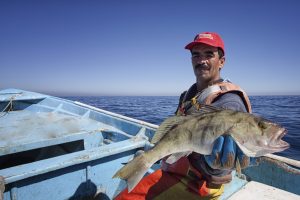
Porfirio Zuñiga displaying a hand-caught sand bass, which he will despatch, bleed and put directly on ice to ensure its freshness Photo © Carlos Aguilar – SmartFish
The SmartFish Difference. Hoyt and his team set out to address these problems by forming a social venture with five fishing cooperatives in Magdalena Bay. The fishermen quickly grasped Hoyt’s vision of higher profitability and sustainability, and Hoyt helped them gain access to funding for the equipment and training they needed to make the vision a reality. The fishermen successfully switched from their high volume, high bycatch gillnetting and trapping techniques to much smaller volume / no bycatch hook and line fishing and eco-traps that have escape hatches for smaller fish and barriers to larger fish. All fish are brought in alive by hand, quickly dispatched and bled, then immediately put into ice water, maintained below 4C.
“This process generates fish that is dramatically different in quality, and the high-end chefs have really been blown away.” Says Drew Deckman “Not only are we willing to pay a premium for the superb quality of fish coming out of SmartFish, we’re willing to pay a premium for the sustainability that is inherent to this process. This is a major win for both the fishermen and the restaurants they serve in Baja.” One of Smartfish’s first customers was El Bismarkcito, a much-loved seafood restaurant in La Paz. The owner, who has been selling seafood under the same trees along the Malecón for decades, at first refused to believe that the fish was one of the species she had bought for years. When finally convinced, the only question she had was, “Can you get me more?”
For SmartFish the challenge now is not demand but supply. The success of the pilot cooperatives is generating considerable interest, but not even all the boats in the those cooperatives have been converted; it takes at least one year to get a fleet up to the SmartFish standard. With a relatively small number of boats in the program, Hoyt currently can personally guarantee that the fish bought by El Bismarkcito or Drew has been caught responsibly. But soon that will change as the number of fisherman in the system increases. To address this issue SmartFish is launching a process of traceability using the technology and techniques of ShellCatch (www.shellcatch.com) in which consumers can track a fish from the fisherman’s hook to their own plates.
Hoyt characterizes all this as SmartFish’s “Value Rescue formula” and is excited that it is yielding “impressive triple-bottom-line outcomes”: 1. Economic
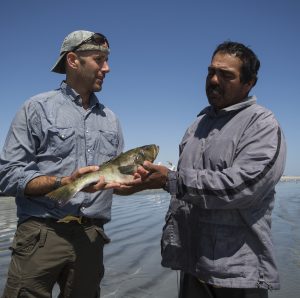
Fisherman Francisco Rodríguez Romero details with pride the quality of his sand bass to Hoyt Peckham Photo © Carlos Aguilar – SmartFish
outcome: fishermen are realizing important price increases, usually exceeding 100%; 2. Power outcomes: Fishermen and their families are taking control of their economic destinies as price setters, and chefs and other retailers are able to offer sustainable and high quality seafood; and 3. Environmental outcomes: there is a 40-60% lower catch volume than the status quo for target species; there are minimum and in some cases maximum size limits; there is decreased fish bycatch and zero megafauna bycatch (no turtles, dolphins etc. killed in gillnets); and a switch to more resilient target populations, i.e. away from grouper and shark towards sand bass and yellowtail.
Drew Deckman is sold. “I’m the governor of Slow Food for the entire Baja peninsula and the vertical integration that Hoyt is seeking in the fishing cooperatives is exactly what I look for in every new location in which I establish operations. Before I was a chef I was a commercial fisherman and a master diver, so for me the SmartFish solution is ideal; it is the logical conclusion of all my efforts. It’s fantastic to work with Hoyt and the cooperatives, and we’re all excited about the change this will bring to the lives of fishermen in Baja.” SmartFish, smart choice.
For more information on SmartFish you can visit their website at http://smartfish.mx/
It’s Not all Dire Straits in BCS
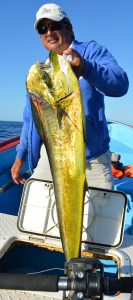
Todos Santos Fisherman Agustin Agundez
Of course not all fishing cooperatives in Baja are subject to the same forces Hoyt describes. Many receive good prices for their fish and have catching and processing techniques that deliver a high quality product to consumers. In Todos Santos, for example, fishermen Agustin Agundez reports that they receive 60 pesos per kilo for desirable fish like cabrilla and huachinango. While some Todos Santos fishermen do use gillnetting, they also fish with hook and line to ensure that local restaurants have the great quality fish for which they are rightfully famous. Chef Dany Lamote of Santo Vino has a great working relationship with the local fishermen. “The fishing cooperatives in Todos Santos know the quality that Santo Vino demands and we are very pleased with the fish we get here. We often buy the fish right off the boat and it is still very cool and very fresh.”
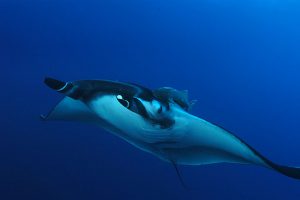
by Bryan Jáuregui | Adventure, Blog, Education, Travel Industry, Wildlife
by Todos Santos Eco Adventures
This article was first published in Janice Kinne’s Journal del Pacifico.
Marine mammals know how to get the love. Fish, not so much. You post a picture of a sea lion or a dolphin on Facebook, and you’re likely to get comments about cuteness, playfulness, intelligence – the emotion you feel when it looks you in the eye. You post a picture of a sea bass or a dorado on Facebook, and you’re likely to get comments about dinner, seasoning, grilling techniques – apparently fish giving us the fisheye doesn’t tug at our heartstrings.
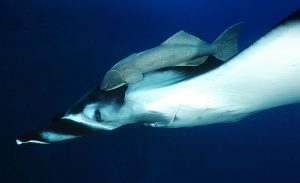
Manta Ray Eye Photo by Kaia Thomson
But there is one fish that no less an authority on charisma than businessman Richard Branson calls “one of the most charismatic creatures in the ocean”, and that is the elegant, enormous, manta ray. With the largest brain-to-body ratio of all elasmobranchs*, the manta ray is one of the most intelligent fish in the sea. Making that brain function well is a system of blood vessels that envelope the manta’s braincase, keeping the brain warmer than the surrounding tissue. A big, warm brain fosters intelligence, intelligence fosters curiosity, and curiosity causes manta rays to interact with human beings in the water. It’s an incredible thrill.
Manta rays are magnificent creatures to behold. It’s not just that they’re huge: they typically reach a width of 22 feet (7 meters) and a weight of over 3,000 pounds (1,400 kg); and it’s not just that they’re prehistoric-looking: they have cephalic fins on either side of their heads to direct food, which look like horns when furled; it’s just that they’re so darn cool: they look like stealth bombers in the sea, yet move that remarkable bulk with utter grace, using their massive triangular wings (pectoral fins) to fly through the sea, exuding the glide and flow of an eagle in flight. So when you realize that this fish that seems straight out of myth is turning in patterns with you, engaging with you, and – like any good dance partner – making direct (fish) eye contact with you, it, well, tugs at your heartstrings.

Manta Ray Coming to Visit Photo by Kaia Thomson
But some people still just see dinner. Despite the fact that fishing for oceanic manta rays was banned in Mexico in 2007, and that the possession and trade of all mantas and mobulids in Mexican waters is prohibited by law, you can walk into local markets in many Baja towns and find stacks of dried and salted rays for sale. They’re considered an excellent, affordable source of protein. On a global scale the problem is more menacing. Across the tropics they inhabit, mantas are now being killed for their gill rakers, the cleansing plates that filter their food from the ocean. Manta and mobula gill rakers are the latest snake oil cure-all in China, touted as a remedy that cleanses the body of everything from gout to cancer. The organization Manta Ray of Hope, which is acting to protect manta rays from this trade, estimates that the annual gill raker trade volume is 61,000 to 80,000 kilograms (135,000 to 176,000 pounds), with an estimated value of US$11.3 million.
But businessman Richard Branson, who is campaigning for manta ray protection, points out that “while the gills are valuable, the trade is also robbing local economies of [the mantas], which could draw millions of dollars each year for those communities.” In fact, Manta Ray of Hope estimates that manta and mobula ray tourism has an estimated annual value of over US$100 million per year, a far more compelling number than the $11 million currently enjoyed by the gill raker trade. If enough awareness is raised and policy makers (and policy enforcers) act quickly enough, there is still time to staunch what many fear could otherwise be the depletion of the global manta ray population.
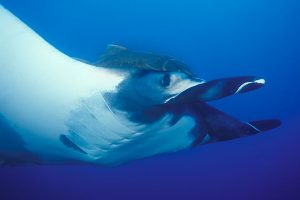
Manta Ray Photo by Kaia Thomson
And in Baja California Sur we know the pure joy of having the mantas and mobulas as neighbors. Many days from the Pacific beach it is possible to see the mobula rays skipping along the water, making that distinctive flap-flap-flapping sound as they soar through the air and hit the water repeatedly. And in the Sea of Cortez we’re starting to see a return of the giant manta rays, with a large number of sightings over the last several months. So if you’re in Baja, take the time out to go engage with these remarkable creatures in their natural habitat, and let their charm work itself on you. Once you get to know them, you’ll definitely be joining Richard Branson in giving the gill raker traders the old fisheye.
*Elasmobranchs are in the Class Elasmobranchii, which covers cartilaginous fishes such as sharks, rays and skates.
Manta Ray Fun Facts:
- Manta is the Spanish word for blanket, an apt description of the manta ray shape
- Like their shark cousins, the manta’s skin is covered with dermal denticals – sort of modified teeth that are covered with hard enamel. These are packed tightly together with the tips facing backwards. Not only do they help in protecting the animals from predators, they also aid in hydrodynamics. Manta skin is also covered in a type of mucus which helps protect it from parasites and infection.
- Manta rays have terminal mouths strategically located at the front of their heads for filtering the large quantities of water they take in as their gill rakers filter out the plankton they feed on (mantas eat about 13% of their body weight each week). Mobula rays have sub-terminal mouths, located underneath the head. While mantas do have teeth, they’re generally nonfunctional – a common occurrence among filter feeders.
- Mantas are relatively long-lived – up to 40+ years.
- Mantas, like other sharks, visit oceanic “cleaning stations” where they cease all movement and open their mouths and gills wide to allow in cleaner fish like wrasses and gobies who happily consume any nutritious parasites that may be present. Mantas repay the favor by not eating the cleaner fish.
- Mantas reproduce via ovoviviparity, i.e., the young hatch from eggs inside the female’s body and the pups are nourished by yolk instead of placenta.
- Female mantas give birth to only one or two pups every two to five years, and will have a maximum of 16 pups over a lifetime. By comparison, a great white shark produces a maximum of 14 pups in just one litter. This combination of long life and infrequent reproduction increase the manta’s vulnerability.
- Manta rays were practically wiped out of the Sea of Cortez due to targeted species fishing in the 1980s and 1990s, but have been making a comeback under federal protection since 2007. It is now possible once again to see, swim and engage with the mantas in the Sea of Cortez. It’s a remarkable life experience.

by Bryan Jáuregui | Adventure, Blog, Culture, Travel Industry, Wildlife
by Todos Santos Eco Adventures
This article was first published in Janice Kinne’s Journal del Pacifico.
When the Supreme Court of the United States ruled in 2010 that “corporations are people”, it was a low day for homo sapiens throughout the world, many of whom felt their “personhood” assaulted, and who resented the notion that their “person” status should be shared with entities lacking a corporeal body ruled by intelligence and passion.
So when in August of this year the government of India became the first in the world to declare all cetaceans – including dolphins – non-human persons, those same homo sapiens breathed a sigh of relief that the standard for personhood had this time been raised, not lowered, and that once again personhood was a mantle to be worn proudly. But what about the dolphins? Did they consider personhood a serious downgrade in their global standing? Douglas Adams, author of the Hitchhiker’s Guide to the Galaxy, offers some insight: “It is an important and popular fact that things are not always what they seem. For instance, on the planet Earth, man had always assumed that he was more intelligent than dolphins because he had achieved so much – the wheel, New York, wars and so on – whilst all the dolphins had ever done was muck about in 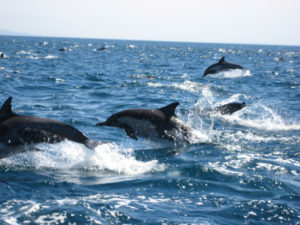 the waves having a good time. But conversely, the dolphins had always believed that they were far more intelligent than man – for precisely the same reason.”
the waves having a good time. But conversely, the dolphins had always believed that they were far more intelligent than man – for precisely the same reason.”
Now of course when the US and Indian authorities declared corporations and dolphins people, they didn’t mean to suggest that either should embrace the institution of marriage, seek political office, or engage in other acts characteristic of homo sapiens with personhood status. What they meant is that both have implicit rights under the laws of the land and should be treated accordingly. For dolphins, this was an acknowledgement not only of their remarkable intelligence, but their human-like self-awareness. In 2001 the National Academy of Sciences published a study from Columbia and Emory Universities that proved dolphins recognize themselves when looking at their reflection. Of all the other animal species on the planet, only humans and our great ape cousins have demonstrated such mirror-awareness, and the researchers concluded that this stemmed from the dolphin’s large brain and advanced cognitive ability. In fact, just prior to the Indian government’s announcement about dolphins, researchers from the University of Chicago published research demonstrating that dolphins can remember the signature whistles – the dolphin equivalent of names – of absent friends for more than 20 years. The study’s author concluded that dolphins are “operating cognitively at a level that is very consistent with human social memory.”
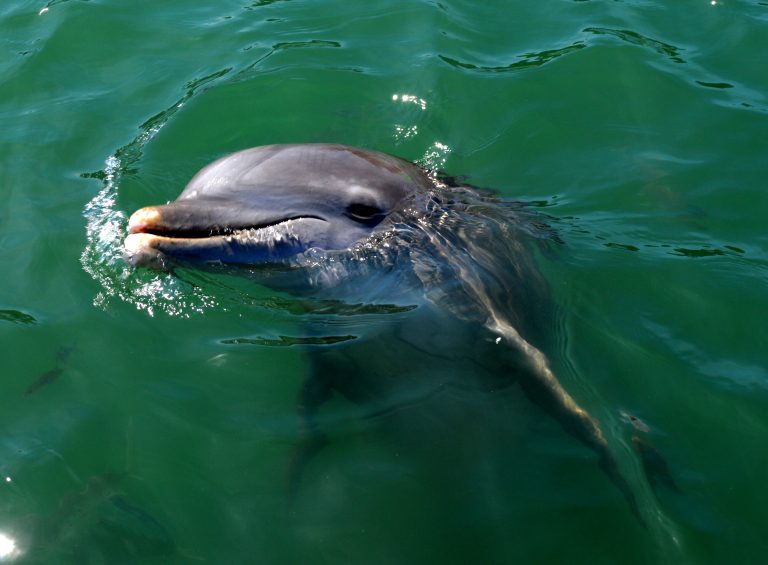 Other studies have demonstrated that dolphins use tools and understand abstract concepts, and it has been long recognized that dolphins form intimate, multi-generational family bonds that last for a lifetime. In short, they’re a lot like us, and the Indian government has honored that similarity by declaring that dolphins essentially have the same rights to life, liberty and the pursuit of happiness as homo sapiens; it banned captive dolphin shows and declared it is morally unacceptable to keep dolphins in captivity. Costa Rica, Chile and Croatia have also banned dolphin displays, while countries such as England and Brazil have regulated dolphin displays so heavily that they have become too expensive to operate. In other words, these nations have fixed it such that corporate persons cannot hold captive non-human persons for the pleasure of human persons. It’s a concept any dolphin brain can grasp!
Other studies have demonstrated that dolphins use tools and understand abstract concepts, and it has been long recognized that dolphins form intimate, multi-generational family bonds that last for a lifetime. In short, they’re a lot like us, and the Indian government has honored that similarity by declaring that dolphins essentially have the same rights to life, liberty and the pursuit of happiness as homo sapiens; it banned captive dolphin shows and declared it is morally unacceptable to keep dolphins in captivity. Costa Rica, Chile and Croatia have also banned dolphin displays, while countries such as England and Brazil have regulated dolphin displays so heavily that they have become too expensive to operate. In other words, these nations have fixed it such that corporate persons cannot hold captive non-human persons for the pleasure of human persons. It’s a concept any dolphin brain can grasp!
Luckily, when visiting Baja California Sur, there are innumerable opportunities for seeking out the joyful companionship of dolphins in their wild ocean homes. In the Sea of Cortez for example, it is not uncommon to see hundreds of dolphins racing together through the sea, always keen for a game of chase and some graceful dolphin gymnastics.
Scott Taylor, founder of the Australia-based Cetacean Studies Institute, wrote a magnificent book in 2003 titled Souls in the Sea: Dolphins,
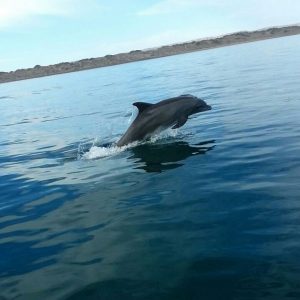
Photo by Daniel Ignacio Ramirez Valenzuela
Whales and Human Destiny. Taylor argues that these mammals, who have inhabited the planet much longer than we have, “possess a deep wisdom about how to live sustainably and joyfully.” Taylor ponders why, after centuries of abuse, whales and dolphins continue to engage with humans. Is there something they are trying to tell us? Are they trying to warn us about what is coming next for the human persons of the world? Again, Douglas Adams has answers in the Hitchhiker’s Guide to the Galaxy. “The dolphins had long known of the impending destruction of planet Earth and had made many attempts to alert humankind to the danger; but most of their communications were misinterpreted as amusing attempts to punch footballs or whistle for tidbits, so they eventually gave up and left Earth by their own means. The last-ever dolphin message was misinterpreted as a surprisingly sophisticated attempt to do a double-backward somersault through a hoop while whistling “The Star-Spangled Banner” – but, in fact, the message was this: “So long… And Thanks For All The Fish!”
But perhaps it is not all over for us human persons yet. Maybe this act of compassion for fellow big-brained mammals by the Indian government will convince dolphins that mankind is worth saving after all. Groups such as SpeakDolpin (www.speakdolphin.com) are actively working on achieving full communication between humans and dolphins, and when they do, perhaps the dolphins will once again tell human persons how to escape the destruction of Earth. The corporate persons, alas, will be left to their own devices.
Fun Facts on Dolphins in the Sea of Cortez
The bottlenosed dolphin loves the Sea of Cortez; it is one of the dolphin species that we see most often when kayaking, snorkeling or boating in its beautiful waters. Some fun facts about our bottlenosed dolphin neighbors:
Similarities to humans:
- Breathes air
- Likes a good joke
- Gives birth to live young
- Stays in touch with friends and family
- Yacks all day long
- Organizes community to achieve common goals such as food procurement
- Plays with its food
- Performs incredible feats to impress females
- Chases off “bad” males trying to get a girlfriend alone
- Forms alliances across family groups for strategic purposes
- Enjoys hanging about fishing with friends all day
- Nurses its young for one to three years
- Has teeth
- Aids and protects those who get hurt
- Likes a good nuzzle
- Sleeps about 8 hours per day
- Enjoys group activities with hundreds of others
- Helps surfers, sailors and snorkelers in distress
Differences from humans:
- Gets as big as 10 – 14 feet (3 to 4.2 m) and 1,100 pounds (500kg)
- Breathing is voluntary, so must keep half it’s brain alert when sleeping to keep the body breathing and also on the look-out for predators
- Often swims while it’s sleeping
- Females are pregnant for 12 months
- Loses all its hair either shortly before or after birth
- Can roll its tongue like a straw so that while nursing a calf can keep salt water out and mom’s milk in
- Relatively short life-span, although some outliers make it to 45-50 years
- Able to leap up to 16 feet – without a pole vault
- Can swim up to 18 mph (30 kph); some say even faster!
- Hunts by echolocation – sending out sound to bounce off objects and receiving back information on an object’s size, shape and location
- Scientific name is Tursiops truncates, which means “a dolphin-like animal with a shortened snout”
- Has a permanent smile on its face




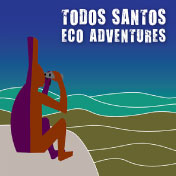

















 the waves having a good time. But conversely, the dolphins had always believed that they were far more intelligent than man – for precisely the same reason.”
the waves having a good time. But conversely, the dolphins had always believed that they were far more intelligent than man – for precisely the same reason.” Other studies have demonstrated that dolphins use tools and understand abstract concepts, and it has been long recognized that dolphins form intimate, multi-generational family bonds that last for a lifetime. In short, they’re a lot like us, and the Indian government has honored that similarity by declaring that dolphins essentially have the same rights to life, liberty and the pursuit of happiness as homo sapiens; it banned captive dolphin shows and declared it is morally unacceptable to keep dolphins in captivity. Costa Rica, Chile and Croatia have also banned dolphin displays, while countries such as England and Brazil have regulated dolphin displays so heavily that they have become too expensive to operate. In other words, these nations have fixed it such that corporate persons cannot hold captive non-human persons for the pleasure of human persons. It’s a concept any dolphin brain can grasp!
Other studies have demonstrated that dolphins use tools and understand abstract concepts, and it has been long recognized that dolphins form intimate, multi-generational family bonds that last for a lifetime. In short, they’re a lot like us, and the Indian government has honored that similarity by declaring that dolphins essentially have the same rights to life, liberty and the pursuit of happiness as homo sapiens; it banned captive dolphin shows and declared it is morally unacceptable to keep dolphins in captivity. Costa Rica, Chile and Croatia have also banned dolphin displays, while countries such as England and Brazil have regulated dolphin displays so heavily that they have become too expensive to operate. In other words, these nations have fixed it such that corporate persons cannot hold captive non-human persons for the pleasure of human persons. It’s a concept any dolphin brain can grasp!